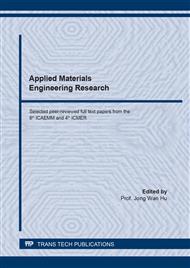[1]
V.V. Vasiliev, V.A. Barynin, A.F. Rasin, Anisogrid lattice structures – survey of development and application, Compos. Struct. 54 (2001) 361-370.
DOI: 10.1016/s0263-8223(01)00111-8
Google Scholar
[2]
L.J. Gibson, Biomechanics of cellular solids, J. Biomech. 38 (2005) 377-399.
Google Scholar
[3]
V.V. Vasiliev, A.F. Razin, Anisogrid composite lattice structures for spacecraft and aircraft applications, Compos. Struct. 76 (2006) 182-189.
DOI: 10.1016/j.compstruct.2006.06.025
Google Scholar
[4]
I. Goda, M. Assidi, S. Belouettar, J. Ganghoffer, A micropolar anisotropic constitutive model of cancellous bone from discrete homogenization, Journal of the mechanical behavior of biomedical materials. 16 (2012) 87-108.
DOI: 10.1016/j.jmbbm.2012.07.012
Google Scholar
[5]
S. Gu, T.J. Lu, A.G. Evans, On the design of two-dimensional cellular metals for combined heat dissipation and structural load capacity, International Journal of Heat and Mass Transfer. 44 (2001) 2163-2175.
DOI: 10.1016/s0017-9310(00)00234-9
Google Scholar
[6]
A.J. Wang, D.L. McDowell, In-plane stiffness and yield strength of periodic metal honeycombs, Journal of Engineering Materials and Technology, Transactions of the ASME. 126 (2004) 137-156.
DOI: 10.1115/1.1646165
Google Scholar
[7]
J.N. Grima, D. Attard, B. Ellul, R. Gatt, An improved analytical model for the elastic constants of auxetic and conventional hexagonal honeycombs, Cellular polymers. 30 (2011) 287-310.
DOI: 10.1177/026248931103000602
Google Scholar
[8]
A. Vigliotti, D. Pasini, Linear multiscale analysis and finite element validation of stretching and bending dominated lattice materials, Mech. Mater. 46 (2012) 57-68.
DOI: 10.1016/j.mechmat.2011.11.009
Google Scholar
[9]
Y.H. Zhang, X.M. Qiu, D.N. Fang, Mechanical properties of two novel planar lattice structures, Int J Solids Struct. 45 (2008) 3751-3768.
DOI: 10.1016/j.ijsolstr.2007.10.005
Google Scholar
[10]
D. Chen, Bending deformation of honeycomb consisting of regular hexagonal cells, Compos. Struct. 93 (2011) 736-746.
DOI: 10.1016/j.compstruct.2010.08.006
Google Scholar
[11]
F. Dos Reis, J. Ganghoffer, Equivalent mechanical properties of auxetic lattices from discrete homogenization, Comput Mater Sci. 51 (2012) 314-321.
DOI: 10.1016/j.commatsci.2011.07.014
Google Scholar
[12]
A. Lebée, K. Sab, Homogenization of a space frame as a thick plate: Application of the bending-gradient theory to a beam lattice, Comput Struct. 127 (2013) 88-101.
DOI: 10.1016/j.compstruc.2013.01.011
Google Scholar
[13]
K. Theerakittayakorn, P. Nanakorn, P. Sam, P. Suttakul, Exact forms of effective elastic properties of frame-like periodic cellular solids, Arch. Appl. Mech. 86 (2016) 1465-1482.
DOI: 10.1007/s00419-016-1129-5
Google Scholar
[14]
P. Sam, P. Nanakorn, K. Theerakittayakorn, P. Suttakul, Closed-form effective elastic constants of frame-like periodic cellular solids by a symbolic object-oriented finite element program, Int. J. Mech. Mater. Des. 13 (2017) 363-383.
DOI: 10.1007/s10999-016-9342-5
Google Scholar
[15]
P. Suttakul, P. Nanakorn, D. Vo, Effective out-of-plane rigidities of 2d lattices with different unit cell topologies, Arch. Appl. Mech. 89 (2019) 1837-1860.
DOI: 10.1007/s00419-019-01547-8
Google Scholar
[16]
H. Gu, M. Pavier, A. Shterenlikht, Experimental study of modulus, strength and toughness of 2d triangular lattices, Int J Solids Struct. 152 (2018) 207-216.
DOI: 10.1016/j.ijsolstr.2018.06.028
Google Scholar
[17]
M. Li, C. Lai, Q. Zheng, B. Han, H. Wu, H. Fan, Design and mechanical properties of hierarchical isogrid structures validated by 3d printing technique, Materials & Design. 168 (2019) 107664.
DOI: 10.1016/j.matdes.2019.107664
Google Scholar
[18]
J. Huang, X. Gong, Q. Zhang, F. Scarpa, Y. Liu, J. Leng, In-plane mechanics of a novel zero Poisson's ratio honeycomb core, Compos. B. Eng. 89 (2016) 67-76.
DOI: 10.1016/j.compositesb.2015.11.032
Google Scholar
[19]
P. Suttakul, T. Fongsamootr, D. Vo, P. Nanakorn, Effects of shear deformation of struts in hexagonal lattices on their effective in-plane material properties, Mater. Sci. Forum. 1034 (2021) 193-198.
DOI: 10.4028/www.scientific.net/msf.1034.193
Google Scholar


